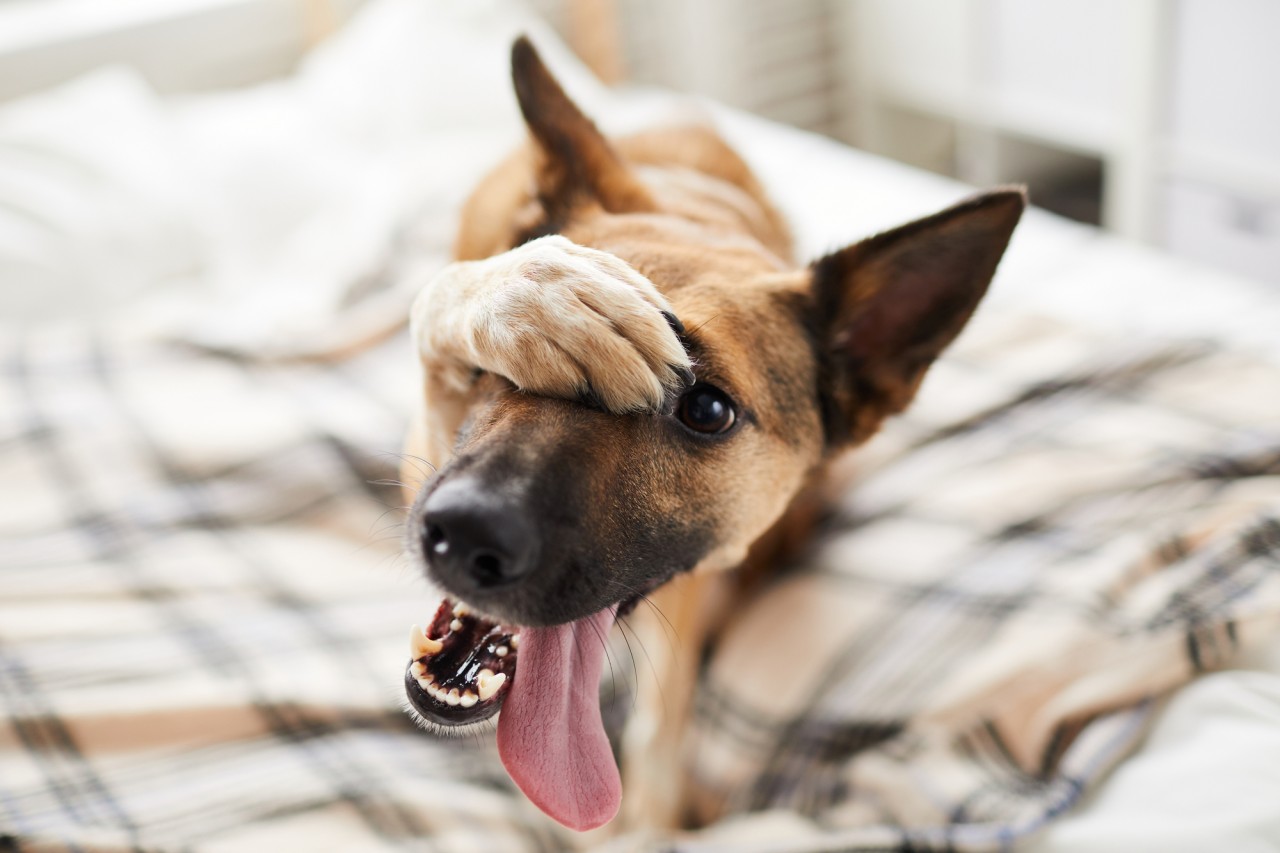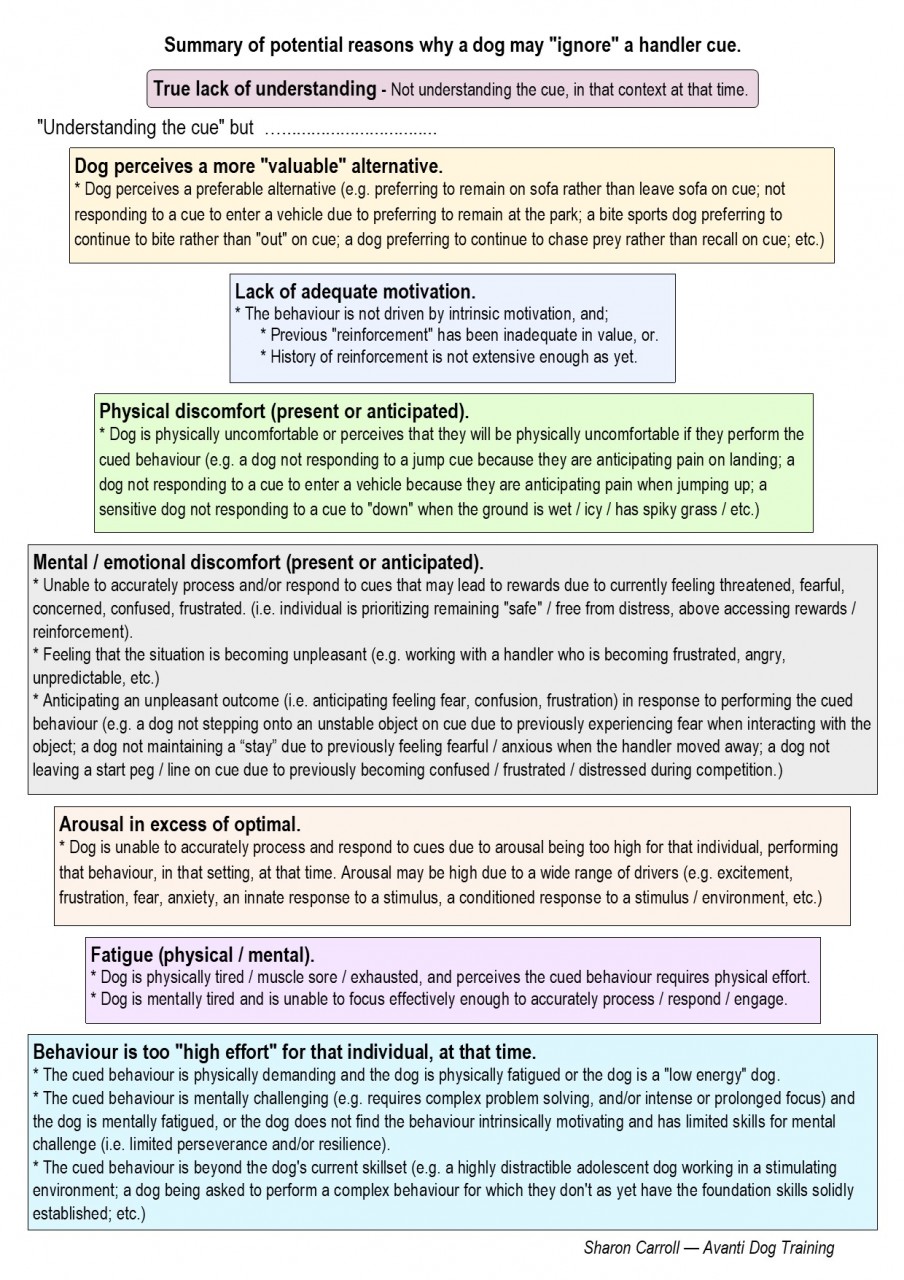Why is my dog not responding to my cue?
Often, we hear the comment, that if a dog doesn't respond to a handler's cue it is because they didn't "understand", but "not understanding" is only one of the many reasons why our dog may not respond rapidly or accurately to our cues.
In this blog we are going to consider the much broader range of potential reasons why our dog may not perform the behaviour we are cueing.
Of course, not fully understanding what the cue means, or not understanding how to perform the cued behavior in a given context, is a very common reason for our dog not performing the behavior we are cueing, hence we should always assess if this is the potential reason, and where necessary make changes to the set-up (i.e. the antecedent arrangement) in order to help our dog to better understand how to perform the behavior we are seeking.
Beyond this though, we get into some complicated territory. What if our dog absolutely knows what we are cueing, but they don't perform the behaviour when cued, then we need to start to analyse why that is happening. Many people jump to the conclusion that their dog is "blowing them off" (i.e. the dog knows what is being asked and is simply electing to ignore the handler), but that is an over-simplification of the myriad of reasons why a dog may not perform a "known" behavior when cued.
Should you "insist" your dog perform a behavior?
In the dog training industry, there is a division between trainers who are prepared to "insist" on a dog performing a behavior on cue, and those that prefer to always allow agency / choice, even with sports behaviors. Sometimes the methodology selected is to do with the trainer's philosophy, and sometimes it is to do with the type of dog(s) they primarily work with (i.e. some dogs will become consistent performers when not given a choice, whilst some dogs will be inconsistent performers unless they feel a sense of agency (i.e. perceived choice)).
Mostly though, "insisting" on a specific behavioral response (whether through the application of negative reinforcement (e.g. "nagging" / demanding), or combined reinforcement (i.e. insisting on the behavior, but then rewarding the behavior), or through the use of punishment (i.e. correction) of alternative behaviors, or through the use of deprivation to increase motivation, etc.), is only going to be a successful strategy (i.e. produce very reliable, consistent responses in all contexts / settings) if the reason the dog didn't perform the cued behavior was because they perceived an alternative behavior to be more valuable. For example, if a bite sports dog is biting and does not perform the "out" on cue, it is very easy to recognize the motivation that drives the continuation of the bite behavior in preference to the "out" behavior; similarly if a dog is playing with another dog and does not recall on cue, it is very easy to recognize the motivation that drives the behavior of continuing to play in preference to returning on cue; another example is a dog curled up on the sofa not responding immediately to a human cue to leave the sofa — it is easy to recognize that the comfort of the sofa is a competing motivator to the potential benefits available for responding to the human's cue to leave the sofa.
"Insisting" that our dog responds to our cues in those types of scenarios may be perceived as warranted; and "insisting" in those types of scenarios is unlikely to cause any emotional issues for our dog (because the only reason the dog didn't respond to the cue, was because they were enjoying the alternative).
However, it is worth noting that in most cases, the same level of reliability can be attained through strategies other than "insisting" – i.e. manipulating the set-up and the reinforcers such that our dog is more motivated to perform the cued behavior.
For example, we could reduce arousal in the training scenario to a level where switching behaviors was easier, and then increase arousal / intensity incrementally to the goal level; we could manipulate the set up so that the alternative behavior was slightly less stimulating / valuable and concurrently increase the value of the rewards available for performing the cued behavior; we could train the behavioral response to the cue through to "habit" level (i.e. develop a conditioned response to the cue), before adding substantial arousal / intensity / emotion, etc.
Where "Insisting" Can Go Wrong
Where things go wrong with "insisting" though, is when a trainer believes that their dog is "blowing them off," when in reality there is a reason other than preference that is driving the incorrect response to the cue.
For example, a dog left on a stay for a position change or recall, that then does not respond to a cue to down or recall, is not doing so because they are really enjoying the sit-stay behavior or the stand-stay behavior; equally a dog left on a start line stay in agility, that "ignores" the release cue (to start running / jumping), is not doing so because they are really enjoying the stay behavior.
Whenever a dog "ignores" a cue, but the alternative behavior they are performing is not highly enjoyable, we need to recognize that there is a more complex reason for the dog not performing the cued "known" behavior, and that "insisting" in these cases may be problematic (i.e. may cause emotional distress) and may also be less likely to create a reliable, confident, behavioral response to the cue long-term (especially at times of heightened pressure / arousal).
What other reasons might cause a dog to fail to perform a cued behavior?
Some of the common reasons a dog may "ignore" a handler's cue are outlined in the attached image.
When assessing potential reasons, it is extremely important that we are accurate (i.e. it is common for people to assume their dog is not fatigued, when he/she actually is; it is common for people to dismiss pain / discomfort as a potential cause, only to find out later that pain / discomfort was a factor; it is common for people to misinterpret behaviors associated with distress as a behavioral representation of excitement (e.g. rapid low tail wagging, appeasement driven "wiggly body", jumping up, taking off on zoomies, cycling through previously reinforced behaviors instead of performing the cued behavior, etc.); it is common for people to incorrectly identify a "shut down" dog as one that is at "low arousal," when in reality the arousal is excessively high and has induced a state of inhibited / slow movement; it is common for people to believe that once they have undertaken a set amount of desensitization work that their dog should no longer be anxious / concerned about aspects of the environment, when they really still are; etc.)
Next time you are working with your dog, and they don't respond rapidly and accurately to your first cue, first consider if they really do understand your cue in that context, then before "insisting" on the behavior, check that your dog really is just "blowing you off" (i.e. they are enjoying the behavior they are already performing and hence don't want to perform the cued behavior at that time).
If the behavior they are performing in preference to performing the cued behavior does not appear to be inherently enjoyable / rewarding, then try to accurately identify the specific reason your dog is struggling to respond to your cue, and make a plan to resolve the underlying cause rather than "insisting" on the cued behavior at that time.
By accepting you will be accessing a service provided by a third-party external to https://www.fenzidogsportsacademy.com/

